13 Why we Eat Anzac Biscuits on Anzac Day
Jamie Howell
The rapidly changing, globalised world and development of new technologies has reinforced the need for a variety of literacies (Bull & Anstey, 2018; Cope & Kalantzis, 2009; Drewry et al., 2019). It is becoming increasingly important for students to learn and develop a variety of skills that enable them to understand, negotiate, analyse, and navigate the breadth of communication, information, media, and text options that they are presented with today (Drewry et al., 2019). The ability to create multimodal texts is an important part of becoming multiliterate (Bull & Anstey, 2018; Drewry et al., 2019). For this task I worked with a Year 2 student, Evelyn. Together we co-constructed an informative multimodal text Why we eat Anzac biscuits on Anzac Day. This was a digital story created on iMovie with the use of semiotic systems including written text, images, and voice narration (Bull & Anstey, 2018). The target audience that Evelyn selected was her Mum (Australian Curriculum Assessment and Reporting Authority [ACARA], 2018).

CONNECTIONS TO THE AUSTRALIAN CURRICULUM
Year 2 English
Literacy:
- ACELY1671 – Create short imaginative, informative and persuasive texts using growing knowledge of text structures and language features for familiar and some less familiar audiences, selecting print and multimodal elements appropriate to the audience and purpose
- ACELY1672 – Re-read and edit text for spelling, sentence-boundary punctuation and text structure
- ACELY1673 – Write legibly and with growing fluency using unjoined upper case and lower case letters
- ACELY1674 – Construct texts featuring print, visual and audio elements using software, including word processing programs
General Capability:
- ICT
(ACARA, 2018)
The Australian Curriculum English (AC: English) plays an important role in the development of reading and literacy skills that allow young people to become confident communicators, imaginative thinkers, and informed citizens (ACARA, 2018). The main learning intention was to create a short digital story using informative text structures and language features, as well as selecting multimodal elements appropriate for the purpose and target audience ACEYL1671 (ACARA, 2018). This learning experience also incorporated handwriting, editing, and use of digital software which aligns with curriculum links ACELY1673, ACELY1672 and ACEYL1674 (ACARA, 2018).
Planning
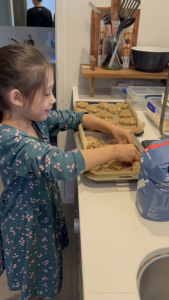
Before I started planning for the learning experience, it was important that I developed an understanding of what to expect when working with a Year 2 student (AITSL, 2011; Ashcraft, 2014). I connected with Evelyn and her Mum on FaceTime prior to meeting up in person. This allowed me to get permission from both Evelyn and her Mum to participate in the learning experience. I also used this opportunity to get to know Evelyn and ask about her interests which I learnt was cooking. The plan was to meet with her face-to-face on Anzac Day, so taking into consideration the context and her interests, I asked if she’d like to make Anzac biscuits (Ashcraft, 2014).
During the planning stage, I revised language development tables to gain an understanding of the expressive and receptive language displayed by children aged 6 – 8 years (Fellowes & Oakley, 2019). I also referred to the AC English: Year 2 content descriptors, achievement standards and exemplars of student work (ACARA, 2018). This revision and exploring the curriculum allowed me to gain better understanding of what to expect when working with Evelyn and plan the learning experience accordingly (Australian Institute for Teaching and School Leadership [AITSL], 2011; Ashcraft, 2014). An example of this is printing out a simple recipe of Anzac biscuits knowing Evelyn would be capable of decoding the text with some guidance (ACELY1669) (ACARA, 2018). I also included a writing element that provides an opportunity for Evelyn to write, re-read and edit her work which aligns with the Year 2 curriculum (ACELY1672) (ACARA, 2018).
Multi-sensory Experiences as a Writing Stimulus
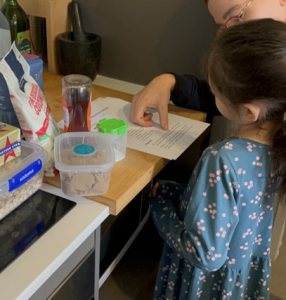
For this learning experience I wanted to provide opportunities for multiple modes of communication which aligns with the multiliteracies theory (Bull & Anstey, 2018). Hence, the main strategy that I implemented was the electronic Language Experience Approach (e-LEA) which allows for the development of a range of literacy skills from oral language through to reading, writing, and viewing whilst using digital platforms (Fellowes & Oakley, 2019). The first step of the e-LEA is to engage the child in a multisensory experience (Fellowes & Oakley, 2019). As it was Anzac Day and Evelyn’s interest was cooking, we decided to make Anzac biscuits.
The strategies implemented within this step were guided reading and questioning (Blank et al., 1978; Fellowes & Oakley, 2019). The recipe provided an opportunity for guided reading whereby Evelyn was able to apply reading strategies, including contextual and phonic knowledge, with guidance to read the recipe (ACELY1669) (ACARA, 2018; Fellowes & Oakley, 2019). Throughout the cooking experience I asked questions such as, “How much flour do we need?” and “Why do we need to be careful when taking the biscuits out of the oven?” (Blank et al., 1978). These questions were asked to encourage recall processes, explain possibilities and reasoning (Fellowes & Oakley, 2019).
The resources used in this step were cooking ingredients, and a printed recipe that was carefully selected within Evelyn’s zone of proximal development to allow for guided reading (Fellowes & Oakley, 2019; Vygotsky, 1978). In accordance with the e-LEA approach, videos and photos were taken throughout the cooking experience to be referred to later (Fellowes & Oakley, 2019).
Discussion and retell of the experience
After the cooking experience, we sat down for a detailed discussion and oral retell of the experience (Fellowes & Oakley, 2019). Photos and videos from the cooking experience were used to facilitate this step and prompted Evelyn to recall and sequence the cooking process (Fellowes & Oakley, 2019). Evelyn was able to provide a full retell of the ingredients and procedure to make Anzac biscuits using appropriate vocabulary and syntax (Fellowes & Oakley, 2019).
During this discussion, Evelyn asked, “Why do we eat Anzac biscuits on Anzac Day?”. I had no idea. So, naturally this became the focus for our informative text. Evelyn and I had originally planned to do a procedural text but when Evelyn posed the question, it presented a great opportunity to create an informative text that would build on the multi-sensory experience by increasing new knowledge rather than simply recalling information. Furthermore, creating an informative text would also create an opportunity for the safe and responsible use of ICTs to gather information through search engines which aligns nicely with the Information and Communication Technology (ICT) General Capability (ACARA, 2018).
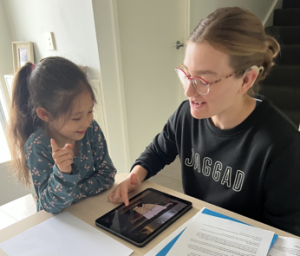
Visual Representation
According to Fellowes & Oakley (2019) step four of the e-LEA is to produce an illustration of a significant part of the experience. Evelyn drew her favourite part of the experience which in her own words was, “When we added the baking soda and water to the butter and golden syrup it [the mixture] started frothing”.
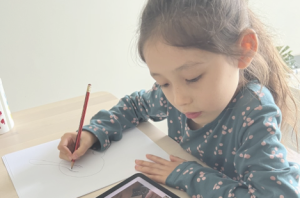
The main strategy used during this step was questioning (Blank et al., 1978). I asked questions about the experience such as “What was your favourite step when making the Anzac biscuits?” “What did we need to do during this step?” and “Why was this your favourite part?” (Blank et al., 1978; Fellowes & Oakley, 2019). These questions were asked to encourage Evelyn to recall, describe, explain, and reason (Blank et al., 1978). The importance of questioning to extend children’s learning is also highlighted in the Early Years Learning Framework (Department of Employment, Education and Workplace Relations, 2009).
Evelyn used a photo taken during the cooking experience to guide her drawing which was then scanned and used as part of the multimodal text. Other resources used were paper and lead pencils. In hindsight, it would have been good to have some coloured pencils.

Scribing the Story
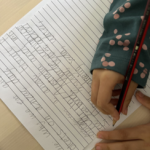
In the e-LEA, according to Fellowes & Oakley (2019), the educator usually types the text whilst the child watches. However, Evelyn was capable of producing a hand-written text that would allow her to practice writing legibly and provide an opportunity to re-read and edit her work (ACELY1672 & ACELY1673) (ACARA, 2018). During this step we explored the text structure and language features of an informative text (ACELY1671) (ACARA, 2018).

The strategy used during this step was the writing conference (Graves, 1983; Fellowes & Oakley, 2019). Evelyn was able to write most of the text herself, but at times needed a prompt on the structure of an informative text or spelling unfamiliar words (Fellowes & Oakley, 2019). The conference provided opportunities for highlighting what Evelyn was doing well and providing feedback when needed (Fellowes & Oakley, 2019).
During this step we used the iPad, safely and responsibly, to research and gather information on Anzac biscuits (ACARA, 2018). Upon reflection, another resource that would have been beneficial is a graphic organiser to highlight the structure of an informative text and a checklist of the basic structure and language features of an informative text to guide her writing and editing process (Rowlands, 2007).
Producing the Digital Format
According to Bull & Anstey (2018) there are five semiotic systems that a multiliterate individual must have to explore and examine multimodal texts: linguistic, visual, auditory, gestural, and spatial. Before starting the digital format, we discussed the semiotic systems that would be used in our multimodal text; linguistic (written text), visual (images) and audio (voice narration) and how these would be implemented to convey meaning (Bull & Anstey, 2018).
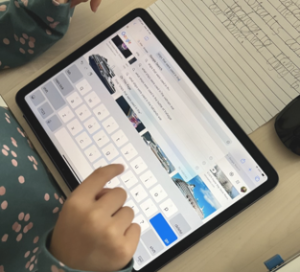
The digital platform used to create the multimodal text was iMovie. Evelyn had never used iMovie before but demonstrated a high level of digital literacy as she picked it up quickly (Hobbs, 2017). The Gradual Release of Responsibility (GRR) strategy was used during this step (Pearson & Gallagher, 1983, as cited in Fellowes & Oakley, 2019). Firstly, I modelled how to use iMovie, showing examples of adding text, images, and audio. Then we worked interactively to create the text and add images. Towards the end of the session, Evelyn was able to independently edit the text, add images and voice-over and move the elements so that they were in time with each other (Fellowes & Oakley, 2019).
Evelyn used the iPad to create the multimodal text, and search Google to look up and select images to support the text (ACELY1671) (ACARA, 2018). The use of iMovie allowed Evelyn to develop her digital literacy and use technology confidently and creatively to meet the demands of living and learning in a digital society (Hobbs, 2017).
Watching the digital story from beginning to end
In the final step of the e-LEA the child re-reads the story (Fellowes & Oakley, 2019). Evelyn was so proud of her work that she watched and read along to her digital story multiple times.
OUTLINE OF THE CHILD’S LEARNING
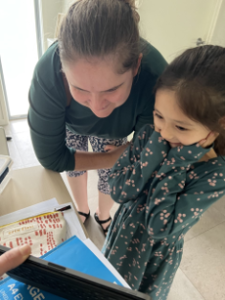
The objectives were for Evelyn to develop knowledge and understanding of the structure and language features of an informative text and understand that texts have an audience and purpose. I also wanted to ensure the process was fun and allowed for the development of positive attitudes towards literacy (Cartwright et al., 2016).
Throughout the scribing process we discussed the features of an informative text, through a writing conference, I was able to assess her knowledge of the structure and language features of informative texts (ACARA, 2018; Fellowes & Oakley, 2019; Graves, 1983). Upon completion of the digital story, Evelyn proudly showed Mum her finished product Why we eat Anzac biscuits on Anzac Day. Mum commented, “I didn’t know that!” which helped reinforce the purpose of informative texts and how multimodal texts can be used to convey meaning (ACARA, 2018). Evelyn’s pride when showing Mum her finished product will help increase her motivation to engage in literacy learning (Cartwright et al., 2016). This learning experience provided opportunities for Evelyn to become a confident communicator, imaginative thinker, and informed citizen (ACARA, 2018).
THE CO-CONSTRUCTED MULTIMODAL TEXT
References
Anstey, M., & Bull, G. (2018). Foundations of Multiliteracies. Taylor & Francis.
Ashcraft, N. (2014). Lesson planning (English Language Teacher Development). TESOL Press.
Australian Curriculum, Assessment and Reporting Authority. (2018). Australian curriculum English: Foundation to year 10 curriculum. https://www.australiancurriculum.edu.au/f-10-curriculum/health-and-physical-education/
Australian Institute for Teaching and School Leadership. (2011). Australian Professional Standards for Teachers. https://www.aitsl.edu.au/docs/default-source/national-policy-framework/australian-professional-standards-for-teachers.pdf
Blank, M., Rose, S., & Berlin, L. (1978). The language of learning: The preschool years. Grune & Stratton.
Bull, G., & Anstey, M. (2018). Elaborating multiliteracies through multimodal texts: Changing classroom practices and developing teacher pedagogies. Routledge.
Cartwright, K. B., Marshall, T. R., & Wray, E. (2016). A longitudinal study of the role of reading motivation in primary students’ reading comprehension: Implications for a less simple view of reading. Reading Psychology, 37(1), 55-91. https://doi.org/10.1080/02702711.2014.991481
Cope, B., & Kalantzis, M. (2009). “Multiliteracies”: New literacies, new Learning. Pedagogies: An International Journal, 4(3), 164–195. https://doi.org/10.1080/15544800903076044
Drewry, R., Cumming-Potvin, W., & Maor, D. (2019). New approaches to literacy problems: Multiliteracies and inclusive pedagogies. Australian Journal of Teacher Education, 44(11), 61–78. https://doi.org/10.14221/ajte.2019v44.n11.4
Department of Employment, Education and Workplace Relations. (2009). Belonging, being and becoming: The early years learning framework for Australia. Department of Education, Skills and Employment. https://www.acecqa.gov.au/sites/default/files/2018-02/belonging_being_and_becoming_the_early_years_learning_framework_for_australia.pdf
Education Council. (2019). Alice Springs (Mparntwe) Education Declaration. https://www.education.gov.au/alice-springs-mparntwe-education-declaration
Fellowes, J., & Oakley, G. (2019). Literacy, language and early childhood education (3rd ed.). Oxford University Press.
Graves, D. (1983). Writing teachers and children at work. Heinemann.
Hobbs, R. (2017). Create to learn: Introduction to digital literacy. Wiley-Blackwell.
Rowlands, K. (2007). Check it out! Using checklists to support student l. The English Journal, 96(6), 61–66. https://intuyuconsulting.com.au/files/Using_Checklists_to_Support_Student_Learning.pdf
Vygotsky, L. S. (1978). Mind in society: The development of higher psychological processes. Harvard University Press.

